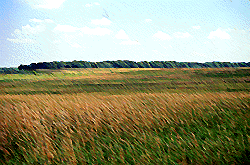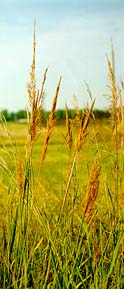

There are prairies three, six, ten, and twenty leagues in length, and three in width, surrounded by forests of the same extent; beyond these, the prairies begin again, so that there is as much of one sort of land as the other. Sometimes we saw the grass very short, and, at other times, five or six feet high. (Louis Jolliet, 1674)![]()
Historically, the Illinois Country was a mosaic of prairies and forests. Illinois is located in the eastern part of an environmental region known as the Prairie Peninsula, a wedge of grassland and deciduous forest that extended eastward from the central Great Plains of Nebraska to northern Indiana. In this area, prairie grasses generally covered the level to gently rolling upland landforms and also occurred on the floodplains of some of the larger rivers. Prairies were maintained by the Prairie Peninsula's relatively dry climate and by prairie fires that periodically swept across the flatter ground and kept the trees in check. Forests generally occurred on unglaciated landforms and, in glaciated areas, on the moist or sloping land located along rivers and creeks.
![]()
In Illinois, prairies originally covered about 55% of the state and were composed of various grasses, sedges, legumes, and composites. The predominant grass species on mesic sites were big bluestem (Andropogon gerardii), Indian grass (Sorghastrum nutans), and switchgrass (Panicum virgatum). Prairie cordgrass (Spartina pectinata) and bluejoint grass (Calamagrostis canadensis) were important species in wet prairies, while dry prairies contained species like little bluestem (Schizachyrium scoparium) and sideoats grama (Bouteloua curtipendula).
![]()
Indian Grass
(Sorghastrum nutans)
Forests occupied about 39% of Illinois and varied in kinds of trees from place to place. Oak-hickory (Quercus-Carya) forests were widely distributed in the northern four-fifths of the state along the Mississippi River and its major tributary streams. Oak-ash-maple (Quercus-Fraxinus-Acer) forests predominated along the Ohio River and its tributaries in southeastern Illinois, and forests of bald cypress (Taxodium distichum) and tupelo gum (Nyssa aquatica) occurred on swampy ground in southern Illinois.![]()
|
|
Copyright © 2000 Illinois State Museum
